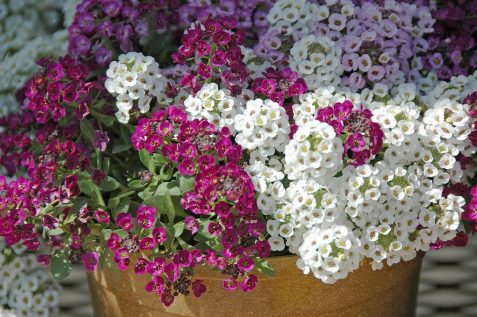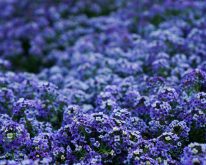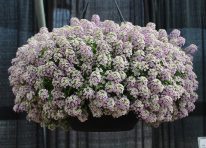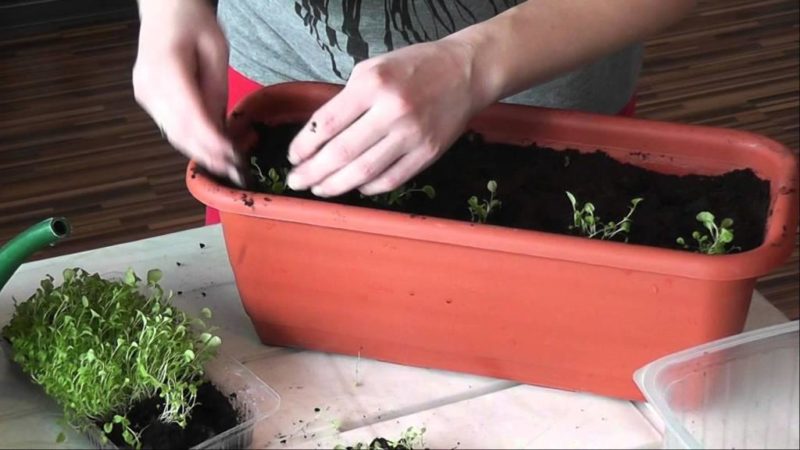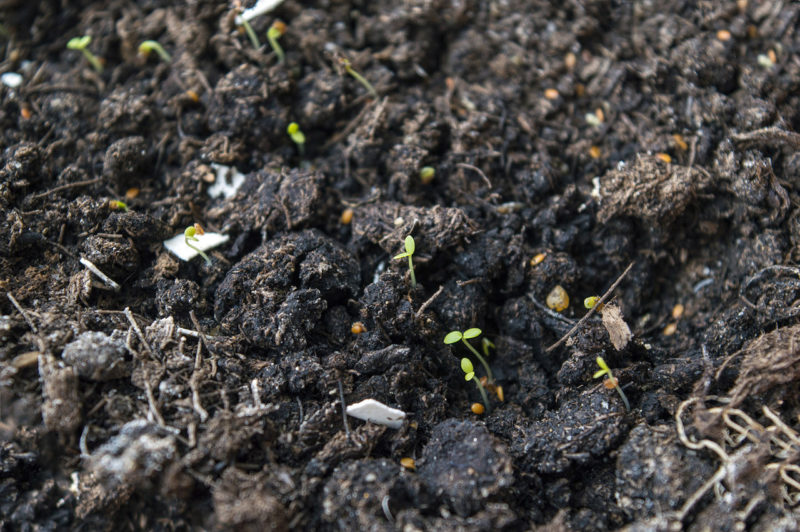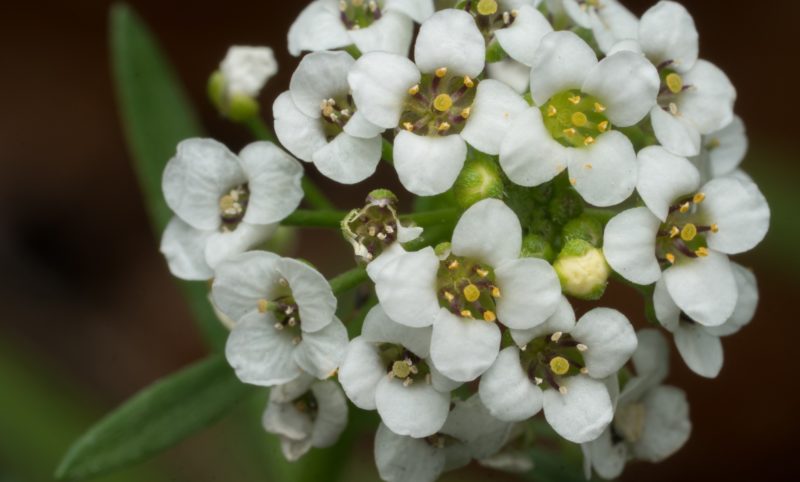Alyssum is a beautifully flowering groundcover. These are alissum flowers that gardeners use to frame flower beds, paths, alpine slides. Numerous inflorescences create a white or pink cloud against the background of a green carpet of leaves.
Material Content:
Characteristics and description of the flower of Alyssum
In the culture, various species of the genus Alyssum are widespread (A. spinosum, mountain and others). These are stunted annuals or perennials 10 to 25 cm high. Some creeping forms and varieties are very stunted (not higher than 8 cm).
Shoots - straight, ascending or creeping. The oblong-oval leaves of some varieties appear silver-gray due to small densely arranged hairs. The color of dense racemose inflorescences of natural species of alissum is most often yellow. Created cultivars with white and pink flowers.
The seaside lobularia plant (Lobularia maritima) previously belonged to the genus Alyssum, the botanical name was different - the sea beetle (A. maritimum). Outdated classification is still confusing. Lobularia, adorning flower beds with fragrant inflorescences, now belongs to the genus Lobularia.
Gardeners and summer residents are used to using the names “sea” or “sweet alissum” and “lobularia” as synonyms, not paying attention to changes in systematics. Meanwhile, Alyssum and Lobularia are different genera of the same family (cruciferous). A “real” alissum or alyssum occupies the same “niche” in floriculture as lobularia.
Planting and care, the use of plants in landscape design are practically no different.
Alissum marine (lobularia) is a perennial groundcover 10-30 cm tall. Dwarf forms (8 cm) have been created.Shoots densely branched with many elongated leaves from 2 to 4 cm long.
Small fragrant flowers with the smell of honey and vanilla are collected in dense racemose inflorescences. The number of petals, like that of other cruciferous ones, is 4. Corolla diameter is 0.5 cm; the color is white, pink, purple, less often dark purple or pink red.
In home gardens and flower gardens, sea alissum is grown as an annual plant. The aboveground part dies in the winter, in the spring numerous seeds germinate, which fell into the soil in the autumn. The bushes grow again in the same place. Flowering lasts 1.5–2.5 months (from June to August). Then, small pods mature with many small seeds.
The main types, varieties of perennial
Mountain allisum (Alyssum montanum) is a drought-tolerant plant for rock garden. The bush is low (10-15 cm), the leaves are silver-gray. Light yellow flowers of perennial alissum of Mountain Gold variety bloom from mid to late spring. The plant needs good lighting, breathable soil, pruning after flowering to rejuvenate. The grade "Mountain Gold" is very popular in landscape design. Use: in rock gardens, near the curb.
Golden yellow flowers of varieties Golden Spring, Berggold together with gray-green leaves form a dense pillow. Planted as ground cover plants in rock gardens, rockeries, used to frame the rabatka. The bushes are undemanding to the soil, relatively frost-resistant.
Alyssum spinozum is an annual or evergreen perennial shrub (depending on climate). The leaves are small, simple, grayish from many short hairs. Four-petalled white-pink flowers, gathered in short brushes, bloom in early summer. Roseum variety is grown in rock gardens, used in a flower misborder, planted in hanging baskets. Propagated by seed and division of the bush. Need pruning after flowering.
Popular varieties of sea alissum: “Royal Carpet”, “Snow Carpet”, “Pink Queen”. Variety mixture of annual Magic cycles mix is sown in early May. Flowering begins in June and lasts until September. White, pink, purple inflorescences appear.
Lobularia or Alissum “Snow Carpet” during the period of mass flowering from June to September looks like a white cloud, almost completely hiding the green carpet of leaves. Shoots ascending or creeping 10–20 cm high.
Growing plants from seeds
Alissum is sown in March in greenhouses, in open ground - from April to June or before winter. In the latter case, the risk of freezing plants is higher. For growing from seeds, you can use a room mini-greenhouse.
On a note! Alissum is sown on seedlings under glass in February.
Pots or containers with seeds put on the windowsill. The soil is kept moist with a spray. Seedlings at a soil temperature of 18 ° C appear quickly, but the formation of these leaves takes 3 weeks. Thinning seedlings, leave between plants 8-14 cm. Hardened at a temperature of about 10-15 ° C.
Alyssum is planted in open ground in groups of 6 plants. If you use varietal mixtures or combine seedlings of various varieties, you get multi-colored pillows. One-color borders can be created using the “Snow Carpet” or “Mountain Gold” varieties.
For planting alissum, a well-lit or semi-shady place is chosen. The plant is poorly clustered and rarely blooms in full shade. Neutral or alkaline soil with sand added to improve permeability.
Basic rules for outdoor care
Alyssum requires a little attention to herself. The soil may be moderately fertile, but always well-drained. Watering in open ground is needed in case of severe drought, in containers and pots - as the top layer of the soil dries.
Too nutritious substrate, fertilizer application can cause abundant growth, the formation of a large number of shoots and leaves to the detriment of flowering. You can feed even after trimming.Cut off the upper parts of the shoots in the summer to stimulate re-flowering.
Flower propagation methods
Natural species and cultivars of alissum are easily propagated by self-seeding. Numerous pods open and the seeds spill out onto the soil. They are frost-resistant, winter even under a thin layer of substrate, quickly germinate in the spring.
The wind picks up light seeds and spreads over the site, so alissum can appear in those places where they were not sown. A pleasant and modest plant sometimes becomes intrusive, occupying cracks and small spaces between paving slabs, on the lawn. Weeding “excess” alissum is not a problem, since the roots of the plant are thin, superficial.
Plants that have spread by self-sowing can be transplanted to other places. It is important not to damage the root system. Alyssum tolerates transplantation well even during flowering, but it is better to perform this procedure on a cloudy day or in the evening.
Alyssum after flowering
Pruning in summer during the period of mass seed formation is necessary to maintain compactness and decorative appearance of plants, to prevent self-seeding. The tops of the shoots are cut (5-8 cm), watered, and liquid fertilizers are applied. Flowering resumes and occurs as intensively as the first time. Annuals bloom for a long time even without pruning.
Pests and diseases
Under dense bushes, weeds hardly grow. Alyssum is little affected by diseases and pests. Excessive moisture and wet weather are dangerous for fragrant lobularia. Plants are more affected when planted too tight. In which case insecticides and fungicides will always come to the rescue.
Alyssum is a hardy annual or perennial. Used in rabatki, alpine slides, rockeries. It develops well even on rocky areas. He prefers sunny places, but is ready to put up with partial shade. A wide selection of varieties with different colors allows you to create floral carpets that delight the look all summer.


